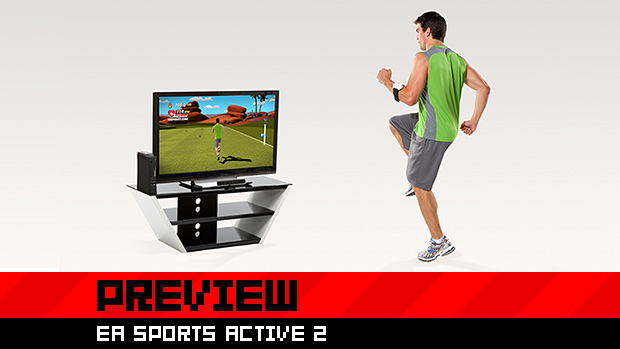EA Sports sure lucked out with Microsoft’s rebranding of Project Natal as “Kinect.” It’s a name that aptly describes what EA Sports Active 2, the sequel to EA’s best-selling Wii title, does: it gets you moving, and it connects to the Web. Those are perhaps its two most significant features, but Kinect brings a new dimension to your workout: it assesses your form and critiques it, just like, well, a real personal trainer.
Oh, and you can play the game completely hands-free, with the Xbox 360 controller sitting on the floor. That’s pretty neat, too.
At an EA showcase in New York City a couple of weeks ago, I saw a demo of Active 2 on Kinect given by Gerard Recio, who is an associate producer on the game and a certified strength and conditioning specialist. Hit the jump to see how the fusion of Active 2 and Kinect can give you a better workout.

EA Sports Active 2 (PlayStation 3, Kinect for Xbox 360 [previewed], Wii, iPhone/iPod Touch)
Developer: EA Canada
Publisher: EA Sports
To be released: November 16, 2010
On both PS3 and 360, Active 2 will provide a hands-free experience — the game will ship with a heart rate monitor that you strap to your left forearm, and that’s it. Why is this significant? It’s a much less clumsy setup: there’s no need to hold the Wii Remote and Nunchuk in your hands or place them in a leg strap. Your movement is much freer, and what’s more, new types of exercises are now available: for example, you can use your own dumbbells, whether they’re five pounds or 25 pounds.
Where Kinect’s uniqueness comes in is with its “Total Body Tracking” system: because the camera has the ability to follow your skeleton, it can analyze your exercises and provide feedback. I watched Recio do a few half-hearted leg lifts, and the game quickly pointed out that he need to lift his leg higher if he wanted to get credit for a rep. Lazy folks might have been able to “cheat” the original EA Sports Active on the Wii, but that’s going to be much more difficult when the all-seeing eyes of Kinect are watching your every move. More instant feedback comes from the heart rate monitor; the game displays your pulse on the screen during exercises. But it doesn’t stop there.

Active 2 is a data-gathering machine, and it does a wonderful job of analyzing all that information and presenting it to you in an easy-to-understand manner so you can literally track your body’s increasing level of fitness. This is all done on an interactive Web-based hub to which your platform (whether 360, PS3, Wii, or iPhone/iPod Touch) connects seamlessly. Recio completed an exercise, and then moved over to a PC where he had loaded up his Active 2 profile. He refreshed the page, and I noticed that it had been updated to include the 61 calories that he had burned only a minute before on his 360.
The hub, I think, is the true brilliance of Active 2. The data provided by the heart rate monitor allows the site to measure your heart rate recovery time, so if you follow your fitness regimen, you’ll see that your heart is getting stronger and more fit — which will let you move on to longer, higher-intensity exercises. The hub’s social features are another major part of helping you to get fit. You can create “workout groups” and invite your friends into them, because as we all know, there’s nothing that will motivate you more than seeing that a buddy has lost ten pounds in a month while you’ve only managed to drop five. And if you’re a more kind-hearted person, you can send him a friendly message to congratulate him on his achievement, while vowing to match him next month.
I saw one potential inadequacy of Kinect: the area of exercises that are performed lying down. Recio got on the floor to do some push-ups, and the in-game model that represented him couldn’t quite decide if he was kneeling or in the proper “up” position to start a push-up. He was eventually able to get the software to recognize his push-ups, and he chalked up the issues to the work-in-progress build of the game. Kinect may or may not be able to handle people sitting down, but since it only has to track movement on a single plane for a push-up — in which your head, shoulders, arms, and hands are at roughly the same distance from the sensor — I think the final software will be fine.

Active 2 is easily the most high-tech fitness-related concept I’ve ever seen. The exercises are only part of the equation; the software’s data-tracking features are what drive you to stay with your regimen, and that’s vital. Everybody wants quick results; I think people often stop working out because they don’t notice a physical difference when they look in the mirror. But when your regimen is supported by the backbone of data that Active 2 tracks, and you can follow your fitness online so you know that you’re getting healthier (even if you don’t necessarily look better), it seems that it would be much more likely to succeed.


